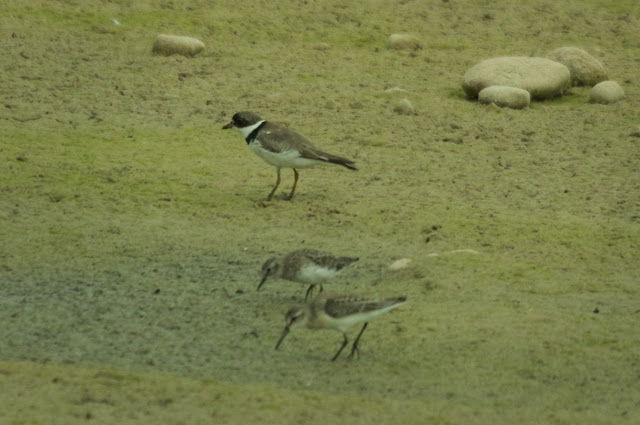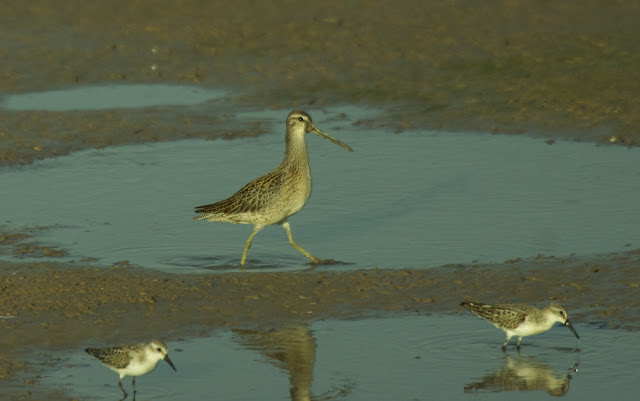These last few weeks have brought some crazy birding in Arizona. The end of August saw a dead Hawaiian Petrel in Yuma--only the third record for the lower forty-eight states--a Brown Booby in Havasu, a Blue-footed Booby in Patagonia, Berylline, White-eared, Plain-capped Starthroat, and Lucifer Hummingbirds, Buff-collared Nightjars, Black-capped Gnatcatchers, Painted Buntings, and now, most recently, a Sinaloa Wren in the Huachucas. There are so many hotspots in Arizona already, and the end of August is prime time for migrants and vagrants. I was having a nice enough time shore birding in Phoenix (yes, it is possible!), but the allure of some of these rarities was too much.
Several of my birding acquaintances were able to get down to Patagonia for the Booby, and they also picked up some great Hummingbirds, along with the August seasonal sparrows, Buntings, and so much other good stuff. Check out their tales and photos
here and
here.
I missed the first trip but was aching to get down there for the seasonal birds and any lingering vagrants. I was fortunate to get the time then last weekend and also fortunate to have some company from a co-worker who wanted to explore the beautiful terrain of southeast AZ. I knew I wouldn't get anywhere near the fabulous haul of birds and photos that my predecessors had, but it could be another ten years before a Blue-footed Booby shows up in Arizona!
The plan was to hit Patagonia Lake early--which meant leaving really early--and then the surrounding countryside, including the San Rafael Grasslands, before stopping by Madera Canyon and doing some feeder-watching before heading north back towards Phoenix.
Upon arriving at Patagonia Lake around 6am, we had singing Cassin's and Botteri's Sparrows in the grasslands, but the first birds we really saw were Vultures, prodigious amounts of Vultures. Perhaps because of their disgusting behaviors, repugnant appearance, and unscrupulous feeding habits Vultures are regarded as ill omens in many cultures and literature. Was our trip doomed from the beginning? Would this effort be the death of us?
Eh, probably not, and admiring the Vultures from a distance wasn't too bad either.
We walked around the Patagonia Lake visitor center, listening to Ash-throated Flycatchers and Sparrows going about their morning business. Some fly-by Cormorants gave us palpitations as we staked out the Patagonia shore, before we finally saw a large, brown and white bird over the tree line.
Yes!!! ABA Code 4 Blue-footed Booby.
It's a juvenile; its feet aren't even that blue, and it's tail primaries look like they're in terrible shape, but none of that diminished the sighting. We watched the young and hopelessly lost Booby plunge-dive several times, while I tried to snap photos as it made determined passes along the lake.
We arrived none too soon either, as it seems the Booby reports have dried up since last Sunday. The jokes to be made with this bird's name are legion, so I won't indulge, but suffice it to say this was one of the breast sightings I've had in Arizona this year.
After ogling the Booby, we spent some time exploring the mesquite bosque around Patagonia Lake. We had several calling Northern Beardless Tyrannulets in the mesquite, North America's smallest Flycatcher and one of the longest-named. They weren't exactly cooperative, but any Flycatcher will hold my attention and fascination as long as it's in view.
With all the recent, above average rainfall, much of the Patagonia lowlands and riparian area was flooded and inaccessible to tennis shoe-wearing dorks such as myself. We walked the ever-lovely Sycamore Creek trail a little ways, enjoying Vermillion Flycatcher and Bridled Titmice, along with a couple of Sora and Wilson's Warblers, but soon we ran out of dry ground.
As the sun climbed higher in the sky, we next headed to Harshaw Canyon and the San Rafael Grasslands, stopping at the famous Patagonia rest stop along the way for Thick-billed Kingbirds, and collecting Cassin's, Western, and Tropical on telephone wires in between. A female Painted Bunting in the creek behind the Paton House was also a treat. Unfortunately, I was having some camera issues and couldn't get my focus operating for the Kingbirds, but knowing they'd be around next year, I checked my list and headed on to the next larger target for the day.
Although the drive through Harshaw Canyon can be pretty treacherous after inclement weather, our trek to the San Rafael Grasslands was very pleasant, as were the handful of Eastern Bluebirds--another state bird, like the Painted Bunting--that we spied along the way.
Google Maps directions underestimate the distance of the Harshaw Canyon drive, and things aren't exactly clearly signed. But just as the tiniest hint of worry started to set in, Harshaw Canyon finally opened to this:
There are so many fabulous, diverse habitats in Arizona, but one of my favorites is grassland. It's not the most productive birding territory, nor even the most grand (like, say, the Grand Canyon), but the sheer expanses of grass and hills totally transport you, taking you to a tremendously quiet, gentle place, and leaving all anxieties behind. Walking around the grasslands, listening to the occasional trill of Grasshopper Sparrows and seeing nothing, other than mountains, in every direction, was incredibly peaceful. I felt like Julia Roberts in the Sound of Music, or a horse with a lot of cool grass in front of it.
Conveniently enough, Grasshoppers Sparrows were also one of my primary targets for the trip, a species I've been wanting to photograph for a while. The adults weren't overly accommodating, given my pains in getting there, but the ratty, juvenile bird below fortunately forgot how to 'sparrow' for a moment, and stayed perched in the open while I fired away.
After visiting the beautiful expanses of San Rafael, it was time to go see more beautiful birds. Madera Canyon, in the Santa Rita Mountains, is about as good a place for that as any in the nation. Feeders outside the Santa Rita Lodge and Chuparosa Inn have been especially productive with Hummingbird this year, and I was both optimistic and anxious to get a lifer Lucifer's or Berylline Hummingbird.
It's funny how jaded one can become with the riches of Hummingbirds in southeast AZ. We didn't have to wait too long for the Lucifer's Hummingbird to show, but in the meantime I pensively sat and took for granted the Broad-billed, Broad-tailed, Black-chinned, Magnificent, and Rufous Hummers that were warming around the Lodge. They are all great bird too, of course, but they can't hold a candle to the Lucifer's Hummingbird (pun points!).
On the way out of Madera Canyon, the last stop for the day was the Proctor Road loop. Chittering Sparrows and Buntings, along with Orioles and empids, made for nice winding down before the drive back to Phoenix. I was also surprised to see a pair of Yellow-billed Cuckoos in the Mesquite bosque, both because it seemed kind of late in the year (which, it turns out, isn't really the case), and because I almost never see them.
Spending a day down in southeast AZ is always fulfilling, and even while I feel the urge to chase birds less than I did a year ago, the pursuits in Patagonia and Madera were very rewarding.The Brown Booby is still over at Lake Havasu too, so there might just be one more late summer chase. Or two, or three...





















































